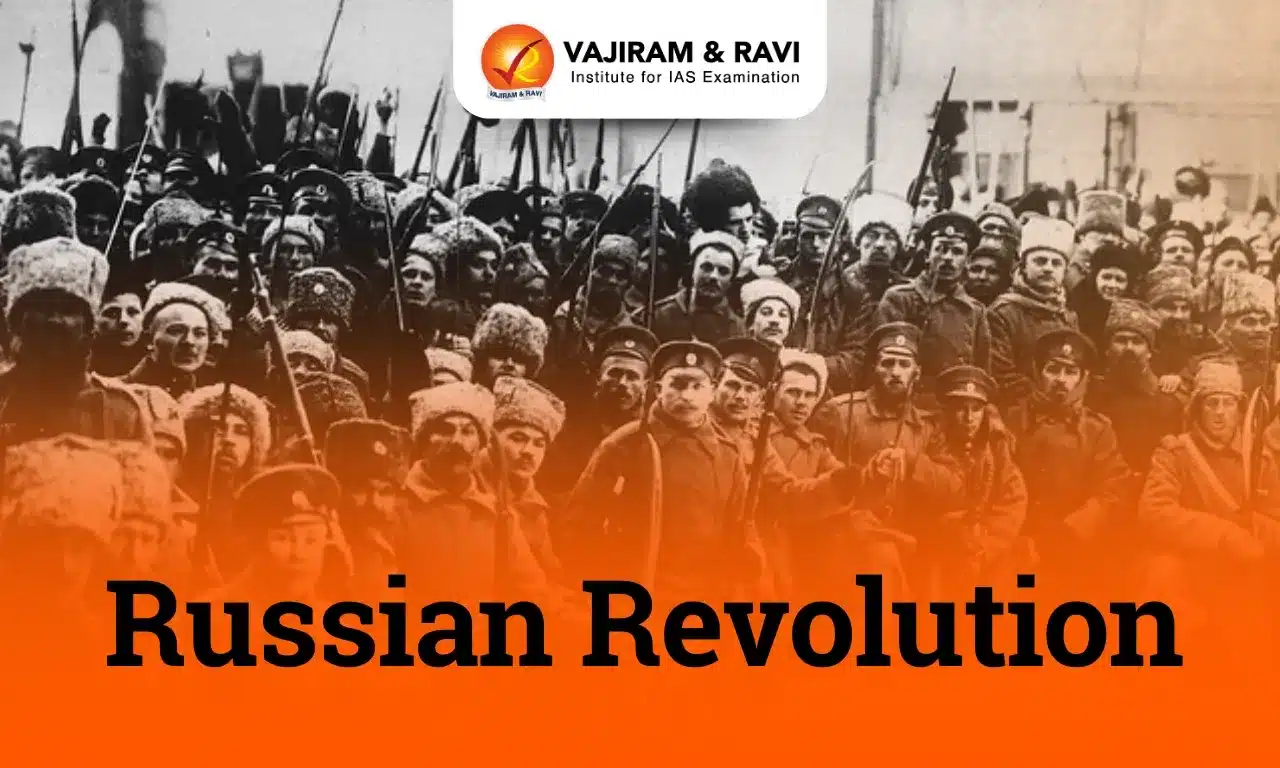The Russian Revolution, also known as the Bolshevik Revolution, occurred in October 1917. It was a proletarian-socialist uprising inspired by communist ideals. It aimed to establish a more egalitarian and just society in Russia. This was the first socialist revolution in history led by the Russian Social Democratic Labour Party, particularly the Bolsheviks, it was driven by the working class, with significant involvement from the peasantry.
The Russian Revolution sought to transform the oppressive social and political system that exploited the working people of Russia. It marked a significant turning point in history, setting the stage for the establishment of the Soviet Union and profoundly influencing global politics for the next 70 years.
Russian Revolution Overview
Russia in the early 20th century was a vast empire ruled by the Romanov dynasty with Czar Nicholas II as an autocratic ruler. The country was plagued by a myriad of social, economic, and political issues that ultimately led to the Russian Revolution, a pivotal event that reshaped the course of world history.
- Japan-Russia War (1904-1905): This conflict emerged due to the territorial disputes over Manchuria and Korea.
- Russia suffered significant military defeats, which weakened the position of Czar Nicholas II and eroded public confidence in his leadership.
- The war highlighted Russia’s military inadequacies and contributed to growing discontent among the population.
- Russian Revolution of 1905: In response to social and economic grievances, workers and peasants staged widespread protests, strikes, and uprisings.
- The Bloody Sunday massacre in January 1905, where peaceful demonstrators were fired upon by the Imperial Guard, intensified public anger.
- As a result, Czar Nicholas II was forced to issue the October Manifesto, promising civil liberties, a constitution, and an elected parliament (the Duma).
- Although the revolution did not fully overthrow the autocracy, it marked a significant shift in Russian politics.
- Russia under Czar Nicholas II: Czar Nicholas II faced mounting challenges during his reign.
- Economic hardships, food shortages, and government corruption fueled disillusionment among the population and the entry of Russia into World War I was made by Nicholas II.
- He left the Russian capital of Petrograd (St. Petersburg) in 1915 to take command of the Russian Army.
- In the absence of her husband, Czarina Alexandra, under the influence of Grigory Rasputin, dismissed elected officials, leading to widespread discontent and calls for the czar’s overthrow.
Russian Revolution Causes
The Russian Revolution of 1917 was a complex and multifaceted event that reshaped the course of Russian history. Here are the key reasons that led to the Russian Revolution:
- The Agrarian Situation and the Peasantry: The agrarian and peasant problem became a significant factor in the Russian Revolution.
- Despite being freed from the bonded peasant system or serfdom (in 1861), the Russian peasantry remained oppressed.
- They had to pay heavily, leaving them in constant debt and forcing them to work for the landed aristocracy at low wages.
- Agriculture, a major sector of the Russian economy, lagged due to a lack of peasant resources for land improvement and the aristocracy’s lack of incentive to introduce new technology.
- The early 20th century saw an increase in peasant uprisings due to growing discontent, making the peasantry an important component of the revolutionary movement.
- Industrialisation and workers’ discontent: Russia’s delayed industrialisation triggered significant social and political changes.
- Urban industrial workers endured poor conditions, low wages, and limited rights.
- The working class became a potent force for change, demanding better treatment and representation.
- Discontent among Nationalities: Russia was a vast empire with diverse ethnic and national groups.
- Nationalist aspirations and cultural differences fueled tensions.
- Minority groups sought autonomy and recognition.
- Participation in World War I: When World War I broke out, Russia joined the conflict alongside the Allies.
- The war placed immense strain on the Russian economy, military, and society.
- Food shortages, inflation, and military defeats exacerbated discontent.
- The devastating Russo-Japanese War of 1904-1905 had already weakened Russia’s position, and World War I further eroded morale and trust in the government.
- Role of intellectuals and Revolutionaries: Intellectuals, writers, and activists played a crucial role in shaping public opinion in Russia.
- The writings of Karl Marx and Friedrich Engels introduced revolutionary socialism to the Russian people, strengthening an environment ripe for change.
- Nihilism in Russia: Nihilists (destroyers) followed the path of individualism and their philosophy was the assassination of maligned officers and even the Tsar to awaken the government and people.
- In the 19th century, authors such as Maxim Gorky, Fyodor Dostoyevsky, and Leo Tolstoy penned works that highlighted human life, freedom, and systemic oppression. Their writings inspired the youth to question the Tsarist regime.
- M. Gorky through his novel ‘Mother’ presented the critical conditions of labourers and farmers in Russia.
- These intellectual writings gave rise to a class of political activists, including figures like Lenin, Kautsky, and Trotsky. These individuals were dedicated to mobilising the Russian population against state oppression.
- The leadership of the Movement:
- Vladimir Lenin: The driving force behind the Bolsheviks, Lenin advocated for radical change, including land redistribution and workers’ control.
- Leon Trotsky: A brilliant orator and strategist, Trotsky played a crucial role in organising the Bolshevik forces during the revolution.
- Joseph Stalin: Although not as prominent during the initial revolution, Stalin would later rise to power within the Soviet Union.
Russian Revolution Events
In the 19th century, discontent grew among aristocrats who found the Tsarist system oppressive.
The movement expanded to include workers and peasants by the early 20th century leading to the following major events:
February Revolution
The revolution took place from February 22 to March 3, 1917, as per the Julian calendar (March 8 to March 16 in the Gregorian calendar). It was a series of protests and strikes that erupted in Petrograd (formerly St. Petersburg) due to widespread discontent.
- Peasants, workers, and soldiers, exhausted by the hardships caused by World War I, took to the streets.
- The majority of the Petrograd garrison joined the revolt and forced Tsar Nicholas II to abdicate.
- The Romanov dynasty came to an end, and the Duma formed a provisional government in its place.
Provisional Government
The Provisional government was led by Aleksandr Kerensky and its primary goal was to guide the country through the transition to democracy.
- The Provisional Government had to navigate the interests of two opposing groups:
- The feudal class favoured a constitutional monarchy.
- The Soviets, representing workers and peasants, sought radical change.
- Striking a balance between these interests proved challenging. Some decisions made by the Provisional Government during the crisis ignited more unrest:
- Continuing support for war: The government chose to continue Russia’s involvement in World War I, despite its detrimental impact on the country.
- Avoiding Constituent Assembly: Fearing Soviet dominance, the government refrained from promptly convening a constituent assembly.
- Constitutional Monarchy: The option of a constitutional monarchy irritated common people who desired more radical reforms.
- Lack of Economic reforms: Economic challenges persisted due to the government’s reluctance to implement significant reforms.
Emergence of Lenin
Vladimir Lenin, the leader of the Bolshevik Party, returned to Petrograd in April 1917 after a 10-year exile. The continuance of the crisis in Russia led to the emergence of Vladimir Lenin. He made the following proposals which were in contrast to the provincial government.
- War termination: Lenin advocated for an immediate end to World War I. Unlike the Provisional Government, he believed that the war perpetuated suffering and drained resources.
- Worker’s control of industries: Lenin wanted industries to be regulated and managed by the working class. This approach aimed at empowering workers and ensuring fair distribution.
- State-controlled production and distribution: He proposed that production and distribution should be under complete state control. This centralised model contrasted sharply with capitalist systems.
- Soviet as the State: Lenin envisioned the Soviet (workers’ councils) as the foundation of the new state. His proposal signalled the end of the monarchy and the establishment of a socialist government.
- The proposals of Lenin satisfied the interests of a large section of the Russian population.
Bolshevik Revolution
The October Revolution, also known as the Bolshevik Revolution, took place between October 24 and 25 (according to the Julian calendar).
- Bolsheviks, led by Lenin, seized power by deposing the Duma’s provisional government, which had been assembled by a group of leaders from Russia’s bourgeois capitalist class.
- Lenin declared that the government would be ruled directly by the councils of soldiers, peasants and workers (Soviets). He reorganised the Soviets and gave the slogan of, “Peace, Prosperity and Development”.
- The Bolsheviks aimed to establish a socialist government and end Russia’s involvement in World War I. And, Lenin became the leader of the world’s first communist state.
Russian Civil War
The Civil War broke out in Russia in 1917 after the Bolshevik Revolution. The factions fighting each other were called the Red and White Armies.
- The Red Army fought for Lenin’s communist government and the White Army was a large group of loosely allied forces including monarchists, capitalists and democratic socialists.
- The Whites had backing from France, the United Kingdom, the United States, and Japan. Reds had internal support.
- The Romanovs were executed by the Bolsheviks on July 16, 1918.
- The Civil War ended in 1923 with the Red Army claiming victory and the establishment of the Soviet Union in 1922 including 5 other nations.
Russian Revolution Significance
The Russian Revolution of 1917 was a transformative event that not only altered the course of Tsarist Russia but also laid the groundwork for socialism in the country.
- Economic aspects: The Russian revolution marked the end of centuries of monarchy in Russia.
- Abolition of private property: The Bolsheviks abolished private ownership of means of production, including land, factories, and banks. These assets were nationalised and became state-owned rather than being in private hands.
- Abolition of Landlordism: In November 1917, the land decree was enacted, abolishing landlordism. The land was redistributed to peasants for hereditary use, ensuring more equitable access to agricultural resources.
- Centralised planning: Under socialism, the Russian people became equal beneficiaries of the country’s resources and economy. Central planning allowed for coordinated development across all regions and sections of society.
- Social aspects: The Russian Revolution championed the cause of social justice.
- By destroying private property in the means of production, the Revolution also destroyed the roots of social inequality. It laid the groundwork for a classless society.
- The new constitution guaranteed free medical care, free and equal education for all, an unemployment allowance, and equal access to culture and cultural advancement.
- Women were not just considered equal, a lot of measures were also taken to make their equal participation in social and political life possible such as maternity leave, public canteens, free crèches at workplaces etc.
- The abolition of serfdom and the push for land reforms aimed to empower the peasantry.
- The revolution challenged traditional hierarchies and advocated for equality.
- The Russian Revolution was an inspiration for all the people suffering from capitalism and imperialism.
- Political Aspects: The overthrow of the imperial government replaced autocracy with a new political order.
- Concept of dictatorship of the proletariat: The Russian Revolution led to the establishment of a working-class state, encapsulated in the concept of the “dictatorship of the proletariat.” It acknowledged that the revolution’s adversaries could still undermine the interests of the people.
- Democratic state: This state was more democratic than the bourgeois countries’ states because it ensured the rule of the majority (working people) over a privileged minority in pre-revolutionary Russia.
- The Bolshevik Party established a one-party socialist regime.
- The revolution fundamentally altered the political landscape, emphasising workers’ control and collective decision-making.
- International Aspects: The Russian Revolution’s ripple effects extended far beyond Russia’s borders, shaping the trajectory of global politics and ideology.
- Inspiration for Anti-Colonialism: The Russian Revolution inspired anti-colonial movements worldwide. Colonised nations saw hope in overthrowing oppressive regimes.
- Challenging Capitalism: The Bolshevik victory challenged the established notion of capitalism. The USSR’s socialist model posed an alternative to capitalist economies.
- Spread of Socialist ideas: The revolution fueled the global dissemination of socialist ideologies, influencing leftist movements and intellectuals in other countries of Europe and other parts of the world.
- Changing the Global Order: The emergence of the USSR post revolution as a major power shifted the geopolitical balance.
- Communists became the major ideology and the USSR became the rival force to capitalism.
- Inspiration to other countries: Countries like China, Cuba, and Yugoslavia drew inspiration from the Russian Revolution in their quests for social change.
Impacts of Russian Revolution on India
The Indian National Movement fueled by the social conditions created by British imperialism and its exploitative system, was also significantly influenced by global currents. Among these, the forces of socialism, epitomised by the Russian Revolution, played a pivotal role.
- Inspiration and Motivation: The 1905 Russian Revolution and the subsequent 1917 Bolshevik Revolution were a great inspiration for Indian leaders and the Indian National Movement.
- The success of the Russian Revolution demonstrated that it was possible to overthrow an autocratic regime through mass mobilisation and revolutionary struggle.
- Influence on Indian leadership: The Russian Revolution led to the propagation and spread of socialist ideas in India.
- Many Indian leaders, including Jawaharlal Nehru, Subhash Bose and the Communists of India, were deeply influenced by the anti-imperialist thrust of the Soviet Union and the ideals of socialism.
- The term “socialism” became pervasive in the political vocabulary of Indian leaders during this time.
- Post-independence, this influence was evident in the economic planning strategies of Nehru, including the Five Year Plans and focus on heavy industries as well as multipurpose projects.
- Rise of the Communist Movement in India: The Russian Revolution inspired the formation of the Communist Movement in India. The first Indian communists were trained in Soviet Russia.
- Leaders like A.K. Gopalan and E.M.S. Namboodiripad broke away from the Indian National Congress and laid the foundations of the Communist Party of India.
- Radicalisation of the National Movement: The growth of the Communist Movement and the influence of Marxism led to the radicalisation of the Indian National Movement.
- Class struggle, including workers’ struggles against the Indian capitalist class, became an inherent part of the Indian struggle for freedom.
- The Indian National Movement became a part of the worldwide struggle against imperialism, led by the Soviet Union.
- Impact on British Policy: The British saw the influence of the Russian Revolution and the “Bolshevik menace” as a threat to their rule in India.
- They issued the Montagu Declaration in 1917, promising gradual self-government, partly in response to the impact of the Bolshevik Decree on Peace.
- The British became increasingly repressive towards nationalist uprisings, perceiving them as “Bolshevik conspiracies.”
Last updated on June, 2025
→ UPSC Notification 2025 was released on 22nd January 2025.
→ UPSC Prelims Result 2025 will be out soon for the CSE held on 25 May 2025.
→ UPSC Prelims Question Paper 2025 and Unofficial Prelims Answer Key 2025 are available now.
→ UPSC Calendar 2026 is released on 15th May, 2025.
→ The UPSC Vacancy 2025 were released 1129, out of which 979 were for UPSC CSE and remaining 150 are for UPSC IFoS.
→ UPSC Mains 2025 will be conducted on 22nd August 2025.
→ UPSC Prelims 2026 will be conducted on 24th May, 2026 & UPSC Mains 2026 will be conducted on 21st August 2026.
→ The UPSC Selection Process is of 3 stages-Prelims, Mains and Interview.
→ UPSC Result 2024 is released with latest UPSC Marksheet 2024. Check Now!
→ UPSC Toppers List 2024 is released now. Shakti Dubey is UPSC AIR 1 2024 Topper.
→ Also check Best IAS Coaching in Delhi
Russian Revolution FAQs
Q1. Was The Russian Revolution a success?+
Q2. Why did the Russian Revolution start?+
Q3. What can be considered the main objectives of the Russian Revolution?+
Q4. How has the Russian Revolution impacted the world?+
Q5. What were the main causes of the Russian Revolution?+
Tags: quest russian revolution




















